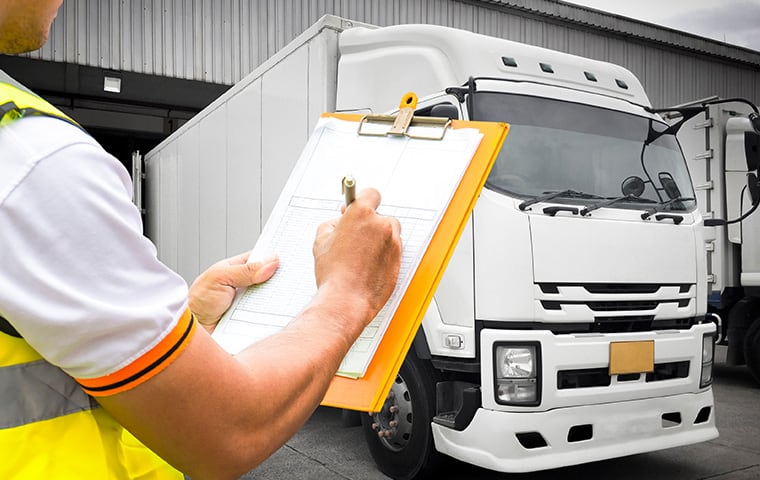
To help prevent accidents and mechanical failures, all truck drivers must complete a pre-trip inspection. While it may be an annoyance to some, it can save lives and decrease liability. An inspection typically requires a driver to do a thorough check of their load, trailer, and commercial vehicle.
Be sure to address any issues or damages before the trip. Compliance, Safety, and Accountability (CSA) violations and fines can be expensive. For example, 7,325 U.S. carriers were fined in 2010, and the average carrier incurred a CSA violation of $8,499. It is in the best interest of both the driver and the fleet to locate the problem before inspectors do. The purpose of a pre-trip inspection is to increase safety, limit downtime, prevent accidents and get drivers to their destinations on time.
What Is a Pre-Trip Inspection?
A pre-trip inspection is a detailed inspection of a vehicle, ensuring that all systems are functioning correctly. The federal government requires vehicles to be inspected daily before driving, which generally takes 30 to 50 minutes to complete. This pre-trip inspection needs to be recorded in a driver’s HoS log as “on-duty, not driving.” Fleet drivers need to do a complete safety inspection of the vehicle’s lights, coupling system, tires, engine compartment, brakes, fuel tanks, chassis, and in-cab.
Pre-trip inspections drastically reduce the chances of accidents and mechanical failures. Roadside repairs cost much more than going to a repair shop, so it’s best to correct problems before beginning a trip. If an accident occurs, assets may be damaged, causing customers to lose faith in your services. In some cases, you may even have to deal with injuries to drivers and others on the road, a situation no fleet manager wants to face. Daily inspections help to reduce costs, improve driver safety and protect company assets.

How to Prepare for a Pre-Trip Inspection
Create a Checklist
A pre-inspection checklist is a common form for drivers to complete before they begin their trip. A thorough list involves six categories to examine:
- Check the fluids in the truck.
- Look for any rust or raised spots on the roof.
- Make sure there’s no leakage in tires.
- Double-check you have enough coolant fluid.
- Ensure all body-panels are tightly attached.
- Most importantly, start the engine.
Most states mandate drivers to pass a Commercial Driver’s License (CDL) test and a Department of Transportation (DOT) pre-trip inspection test. Both will teach you how to complete pre-trip and post-trip inspections correctly.
Keep Records to Avoid Fines
Having records of previous pre-trip inspections is crucial when it comes to avoiding fines. If you are pulled over or asked to demonstrate an inspection at a weigh station, you will need to show proof of previously completed inspections. Police officers or inspectors can administer penalties or fines, resulting in delays due to repairs. If the fault is serious, your truck must be towed to the nearest repair shop. If certain parts don’t require immediate repair, you will need to provide documentation at a later date.
Stay Current with FMCSA Regulations
Non-compliance with the Federal Motor Carrier Safety Administration (FMCSA) is one of the most common ways to get a fine and lower your CSA score. Follow the latest FMCSA regulations on their website to remain compliant. Fleet managers should offer educational services to ensure their fleet drivers are up to date with safety protocols, pre-inspection updates, and driving regulations.
Know What Warrants Roadside Inspections
Depending on the state, some inspectors will pull drivers over if they discover moving violations, while others will spot check CDL vehicles at weigh stations. During these checks, inspectors usually don’t have time to perform a thorough review. Certain red flags will garner your drivers closer attention, so it’s a good idea to be aware of them.
One sign that a driver may not routinely complete pre-trip inspections is if they keep a messy truck. Additionally, other traffic violations, like speeding, can warrant a roadside inspection. It’s always best to obey the law to limit the chances of these surprise examinations. If an impromptu inspection does arise, remember to remain pleasant and have all of your documentation easily accessible.
Don’t Overlook Any Inspection Items
During the pre-trip inspection, some drivers may rush the process and overlook these critical eight items:
- Look for cleanliness
- Double-check wheel chocks
- Test the truck’s brakes
- Possess an emergency kit
- Check reflectors
- Ensure seat belts aren’t damaged
- Make sure the wheel fasteners are tightened
- Prepare all the necessary documents (vehicle registration, trailer ownership, and permits, proof of inspection).
For drivers that use eLogs, be sure to have proper documentation on hand. Another missed component of pre-trip inspection is the expiration dates of one’s commercial driver’s license and the safety inspection approval sticker. Verify that these items are current or renew them ASAP if needed.
Key Takeaways
The key to a successful pre-trip inspection is to take your time. Methodically work your way around each section of your truck and perform each check thoroughly. It’s vital to ensure the safety of your drivers, vehicles, and products as well as the lives of others on the road.








